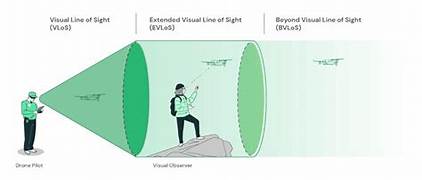Beyond Visual Line of Sight (BVLOS) Drones: Challenges and Opportunities
Drones have revolutionized various industries by offering cost-effective and efficient solutions for tasks such as logistics, agriculture, surveillance, and infrastructure inspection. However, most drone operations today are restricted by Visual Line of Sight (VLOS) regulations, requiring operators to maintain direct visual contact with the drone during flight. This limitation significantly affects the range and scalability of drone applications. Beyond Visual Line of Sight (BVLOS) technology, on the other hand, allows drones to operate beyond the operator’s field of view, unlocking new possibilities for automation and large-scale deployments. While BVLOS drones hold immense potential, their widespread adoption faces several challenges, including regulatory barriers, technological limitations, and safety concerns.
BVLOS operations allow drones to be used in long-range applications, making them invaluable in several sectors. In logistics, BVLOS drones can be deployed for long-distance package deliveries, particularly in remote areas where conventional transportation is inefficient. Companies like Zipline and Wing are already using BVLOS drones to deliver medical supplies and essential goods, significantly reducing delivery time. In agriculture, BVLOS drones play a crucial role in crop monitoring, precision spraying, and soil health analysis, helping farmers optimize resources and increase productivity. Similarly, infrastructure inspection is becoming safer and more cost-effective with BVLOS drones being used to monitor power lines, railways, pipelines, and oil rigs. These drones eliminate the need for manual inspections, reducing risks to human workers. Additionally, in disaster management and search-and-rescue missions, BVLOS drones offer a significant advantage by providing real-time situational awareness, locating missing persons, and delivering emergency supplies in hazardous environments.
Despite their vast potential, BVLOS operations face stringent regulatory challenges. Aviation authorities like the Federal Aviation Administration (FAA) in the U.S. and the European Union Aviation Safety Agency (EASA) in Europe impose strict guidelines to ensure the safety of BVLOS flights. One of the major regulatory requirements is the implementation of detect-and-avoid (DAA) systems, which enable drones to autonomously identify and avoid obstacles, aircraft, and other hazards. Unlike VLOS operations, where an operator manually navigates the drone, BVLOS drones must rely on advanced technologies such as radar, LiDAR, and AI-driven computer vision for safe flight. Additionally, maintaining a secure and reliable communication link between the drone and its operator is critical. BVLOS operations require uninterrupted command and control (C2) communication, which is often facilitated through radio signals, satellite networks, or 5G cellular connectivity. However, factors like signal interference, latency, and cybersecurity risks pose significant challenges, particularly in remote areas with weak network coverage.
Another major challenge for BVLOS drones is their integration into existing airspace management systems. Since most air traffic control systems are designed for manned aircraft, integrating autonomous BVLOS drones safely into national airspaces is a complex process. To address this, aviation authorities are developing Unmanned Traffic Management (UTM) systems, which will help coordinate drone operations and prevent mid-air collisions. However, widespread implementation of UTM is still in progress, and obtaining BVLOS flight approvals remains a lengthy and expensive process for businesses.
Technological advancements are crucial in overcoming BVLOS limitations. Autonomous navigation and obstacle avoidance systems must be further refined to ensure drones can safely operate in dynamic environments without human intervention. Additionally, power limitations continue to restrict BVLOS flight durations, as most commercial drones have limited battery life. Researchers are exploring alternative energy sources, such as hydrogen fuel cells and solar-powered drones, to extend flight endurance and operational range. Improvements in AI and automation will also play a crucial role in enhancing the efficiency of BVLOS drones. AI-powered flight systems can help drones adapt to changing environments, optimize flight paths, and respond to emergencies more effectively.
Despite these challenges, the future of BVLOS drones looks promising as industry leaders, regulatory bodies, and technology developers work towards standardizing BVLOS operations. The deployment of 5G networks will further improve BVLOS capabilities by enabling low-latency, high-speed data transmission, ensuring real-time control over long distances. As BVLOS regulations continue to evolve, more businesses will be able to scale their operations and integrate drones into various commercial applications.
In the coming years, BVLOS drones will become an essential part of the drone ecosystem, transforming industries and enabling smarter, more efficient aerial solutions. While regulatory approvals and technological improvements remain key challenges, ongoing innovation will help unlock the full potential of BVLOS technology. As AI, automation, and connectivity continue to advance, BVLOS drones will play a crucial role in shaping the future of autonomous aerial operations, making transportation, infrastructure management, and emergency response faster, safer, and more efficient than ever before.
.png)






Leave a Comment
Your email address will not be published. Required fields are marked *